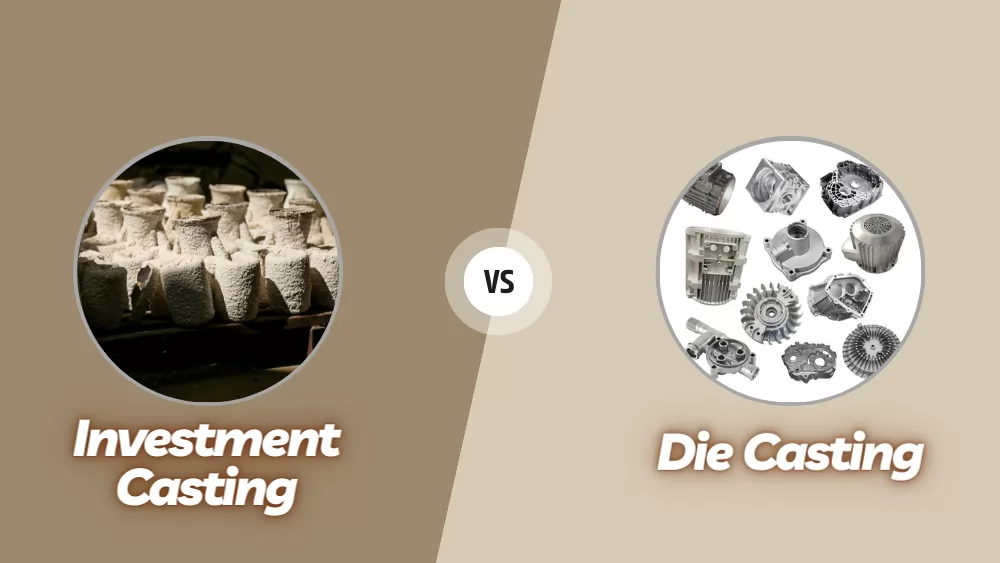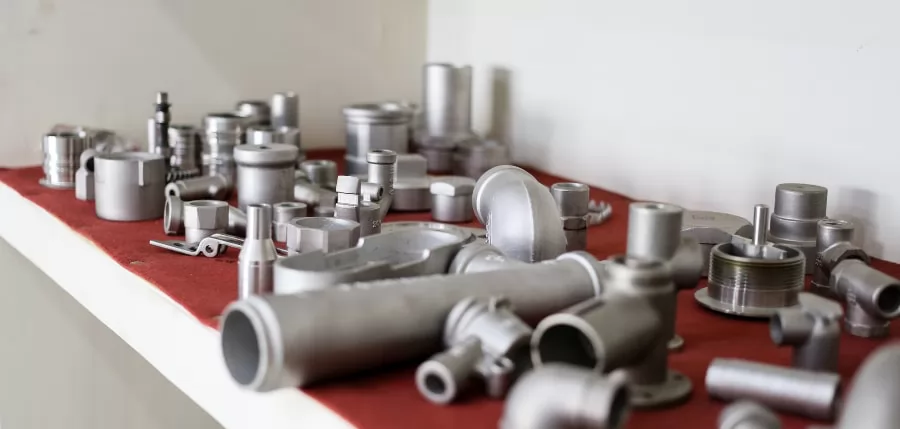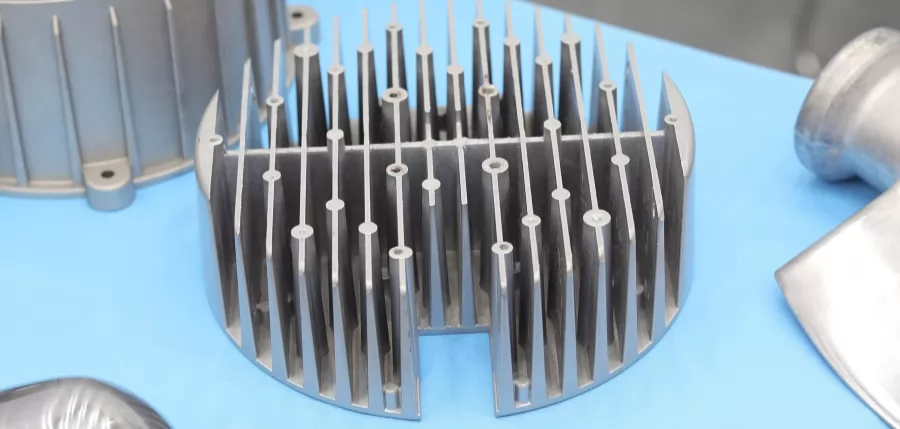
Investment casting and die casting are both traditional metal casting manufacturing techniques that allow various metals and alloys to be formed into many different shapes and sizes. Investment casting process technology is often used to create complex parts with fine details and thin walls, while die casting process technology is used to create parts with complex geometries and tight tolerances.
The choice between investment casting and die casting depends on a variety of factors, such as the desired characteristics of the end product, throughput, cost considerations, and the specific requirements of the application. This article will compare the investment casting process with the die casting process in terms of manufacturing process, materials used, and productivity.
From this article you will learn:
- Definition of Investment Casting and Comparison with Die Casting Process
- Advantages of Investment Casting Over Die Casting
- Disadvantages of Investment Casting Over Die Casting
- Definition of Die Casting Process and Comparison with Investment Casting
- What Are the Advantages of Die Casting Compared to Investment Casting?
- What Are the Disadvantages of Die Casting Compared to Investment Casting?
- Investment Casting vs. Die Casting: Key Differences Comparison Chart
- What Should You Choose?
- When to Choose Investment Casting?
- When to Choose Die Casting?
- Summary
Definition of Investment Casting and Comparison with Die Casting Process
Investment casting is also called precision casting, or lost wax casting. The process starts with creating a wax pattern like the shape of the desired component. Attaching the wax model to the sprue repeatedly to form tree assembling. Dipping the assembly into liquid ceramic to form a protective layer and removing the wax by heating it in the oven. Then fill the shell with liquid metal and cool it the room temperature. Finally, the shell gets solid shape components.
Advantages of Investment Casting Over Die Casting
Listed below are some of the advantages of investment casting compared to die casting:
- Superior design flexibility for intricate parts.
- Higher surface finish quality.
- Ability to use a wider range of materials.
- Lower tooling costs for prototyping.
- Near-net shape parts with minimal machining.
- Reduced material waste.
Disadvantages of Investment Casting Over Die Casting
Listed below are some of the disadvantages of investment casting compared to die casting:
- Because the process of making wax patterns and ceramic molds is labor-intensive, investment casting tends to be more expensive than die casting.
- Compared to die casting, investment casting generally has slower production rates, making it less suitable for low-volume production.
- Compared to die casting, investment casting may require additional finishing processes to achieve the desired surface quality
Definition of Die Casting Process and Comparison with Investment Casting
Die casting stands as a widely favored permanent mold metal casting technique renowned for its efficiency and precision. In this process, molten metal is forcefully injected into a carefully crafted mold under high pressure, thereby solidifying into the desired metal cast. Typically referred to as pressure die castings, these components find extensive application across various industries including automotive, appliance manufacturing, and toy production, owing to their exceptional durability and dimensional accuracy.
What Are the Advantages of Die Casting Compared to Investment Casting?
- Die casting tends to be more cost-effective for high-volume production due to shorter cycle times and lower labor costs.
- Die casting has faster production rates compared to investment casting, making it suitable for large-scale manufacturing.
- Die casting typically produces a smoother surface finish without the need for extensive post-processing, resulting in a higher quality final product.
What Are the Disadvantages of Die Casting Compared to Investment Casting?
- Due to limitations in mold design and manufacturing, die casting may have limitations compared to investment casting in accommodating extremely complex designs or features.
- Higher mold costs: The initial production cost of die casting molds can be high, especially for complex parts, which increases the upfront cost of die casting compared to investment casting.
- Surface imperfections: Die casting can cause surface imperfections such as voids, shrinkage, or cast burrs, which may require additional finishing processes to resolve, unlike investment casting, which typically produces a smoother surface finish.
Investment Casting vs. Die Casting: Key Differences Comparison Chart
| Aspect | Investment Casting | Die Casting |
|---|---|---|
| Process | Uses wax patterns and ceramic molds | Molten metal forced into steel molds under pressure |
| Production Rate | Slower | Faster |
| Surface Finish | Typically requires additional finishing processes | Generally smoother without additional processes |
| Complexity | Good for complex shapes, but with limitations | Accommodates intricate designs and features |
| Material Options | Broad range, including high-temperature alloys | Wide variety, including aluminum, zinc, magnesium |
| Size Capability | Smaller parts with limitations | Larger parts efficiently produced |
| Cost Efficiency | Higher initial costs, labor-intensive process | Lower initial costs, more efficient production |
| Lead Time | Shorter lead time for tooling and setup | Longer lead time for tooling fabrication |
| Applications | Aerospace, automotive, jewelry, medical devices | Automotive, appliance components, consumer goods |
Materials Comparison
Investment Casting: Supports a wide range of materials, including ferrous and non-ferrous alloys, and is particularly suitable for high-temperature alloys.
Die Casting: Offers versatility in material selection, including aluminum, zinc, magnesium, and copper-based alloys.
Production Rate:
Investment Casting: Generally slower compared to die casting due to the time-consuming process of creating wax patterns and ceramic molds.
Die Casting: Offers faster production rates, making it suitable for high-volume manufacturing.
Surface Finish:
Investment Casting: May require additional finishing processes such as machining or polishing to achieve the desired surface finish.
Die Casting: Typically yields smoother surface finishes without the need for extensive post-processing.
Complexity:
Investment Casting: Well-suited for intricate designs and complex geometries, including internal features and thin walls.
Die Casting: Also accommodates intricate designs and features with high precision, but may have limitations compared to investment casting for certain complex shapes.
Size Capability:
Investment Casting: Generally used for smaller to medium-sized parts due to limitations in mold size and handling of larger molds.
Die Casting: Capable of producing larger and heavier parts efficiently, making it suitable for a broader range of applications.
Cost Efficiency:
Investment Casting: Initial setup costs can be higher due to tooling and mold-making expenses, but may be cost-effective for low to medium volumes.
Die Casting: Offers lower per-unit costs for high-volume production runs due to faster cycle times and reduced labor requirements.
Lead Time:
Investment Casting: Generally shorter lead times for tooling and setup compared to die casting.
Die Casting: Fabrication of die casting molds can have longer lead times, leading to potential delays in production startup.
Applications:
Investment Casting: Commonly used in aerospace, automotive, jewelry, medical devices, and other industries where precision and intricate designs are required.
Die Casting: Widely employed in automotive, appliance components, consumer goods, electronics, and various industrial applications requiring high-volume production.
What Should You Choose?
Die casting and investment casting stand as two distinct and commercially significant manufacturing methods, particularly valued for crafting high-strength steel or metal parts. Although they share common ground in their utility, they exhibit notable differences that warrant careful consideration. Hence, discerning which method best suits your specific circumstances proves advantageous.
When to Choose Investment Casting?

1. When you need ferrous and non-ferrous metals
When your manufacturing requirements necessitate the use of both ferrous and non-ferrous metals, it underscores the importance of material flexibility. This entails the need for a diverse range of materials, encompassing not only conventional options like stainless steel but also high-temperature alloys and exotic metals. Such versatility ensures that your production process can effectively adapt to the specific material properties and performance characteristics demanded by your application.
2. When you need net shape products
Investment casting shines in its ability to offer extensive design freedom and adhere to strict tolerance requirements, making it a standout choice for intricate and precise applications. The process allows for the utilization of a wax master pattern, facilitating the seamless incorporation of subtle design elements with ease and precision. This makes investment casting particularly well-suited for recreating models featuring complex patterns and intricate net shape features.
When to Choose Die Casting?

1. When you need large parts
Die casting products boast larger dimensions compared to those produced through investment casting. Die casting offers the versatility to manufacture parts of virtually any size, albeit necessitating more intricate and costly machining processes. In contrast, investment casting faces challenges in accommodating larger parts due to considerations surrounding the lost wax process and specific requirements during the pouring phase.
2. When you need fast turnaround time
Following the preparation of the die casting mold, the subsequent production and output of parts seamlessly transform into a straightforward and highly repeatable process. Die casting demonstrates a remarkable affinity for automation, making it an ideal candidate for integration into modern manufacturing facilities such as large-scale die-casting operations. Moreover, the production outcomes for finished parts exhibit commendable speed, further enhancing the efficiency of the process.
Summary
This article looks at investment casting vs. die casting, explains what they mean, and discusses the pros and cons of each. To learn more about custom precision metal castings, please contact a Besser representative.
Besser offers professional manufacturing capabilities for all your prototyping and production needs. Please visit our website to learn more or request a free quote.



